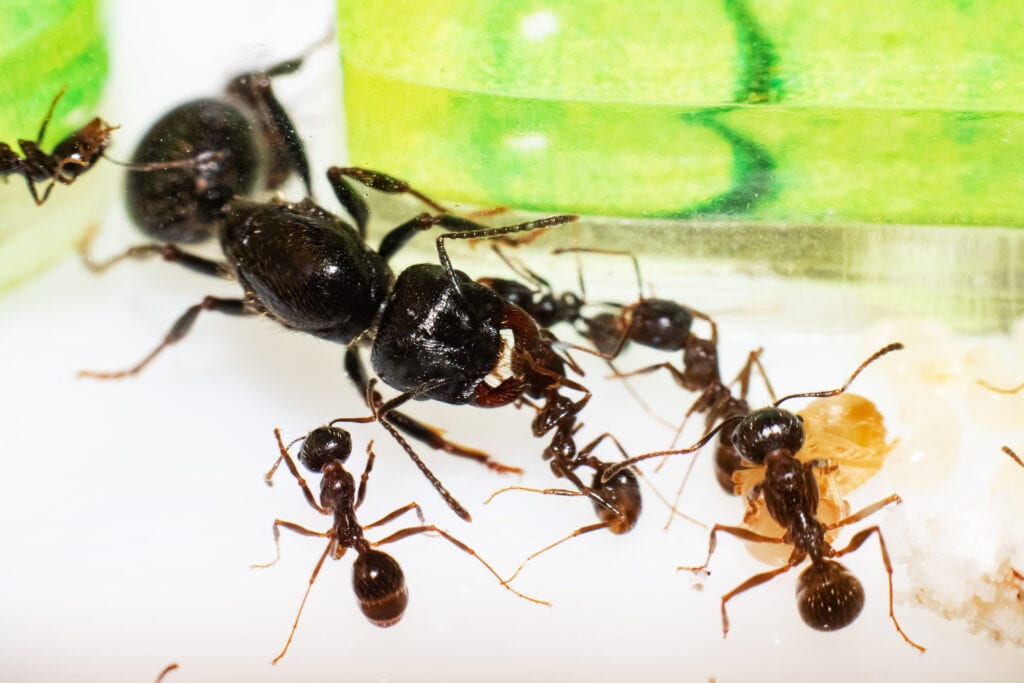You’ve probably seen ants carrying some small white stuff above their head.
Have you ever wondered what those white things ants carry are?
Even though it may not be immediately apparent to the naked eye what the little white things are, in most cases, it’s just tiny bits of food.
However, when ants are hastily and frantically moving with white things above their head, there’s a good chance those little white things are egg balls, larvae, and pupa.
But, to differentiate the white things, you need to look closely (like using a magnifying glass close)
So, while it may seem like “it’s just food,” – it’s not always that.
Ants do sometimes spice it up, transporting their larvae and eggs around.
And also sometimes steal from other colonies.
Let’s jump right in.
The Ant lifecycle and the white things
The lifecycle of the ant species, like that of insects, starts with an egg.
The egg then hatches to larva, then changes to pupa before becoming an adult ant.
The queen lays all the eggs, and a batch of eggs will look like a rice seed.

The eggs are usually white; as they metamorphize into different stages, the white color doesn’t change.
What white things do ants carry?
Ants scavenge on many things, not just ordinary food.
Sometimes, part of the colony’s food is looted from other ant colonies or insect cocoons.
When they overrun rivals, they steal eggs and larvae and return them to the nest.
Thus in some cases, you may notice ants carrying white things, such as stolen larvae and pupa.
Ants are organized and maintain their nests meticulously to avoid diseases.
As they clean the nest, they move the unwanted trash from the nest to dumpsites at the nest’s opening.
Trash is part of the white things that ants move to keep the nest clean and habitable.
However, when unconducive conditions arise in the nest, the ants will look for a safer place to live.
The ants move little white things as they vacate the old nests.

Ant eggs are tiny and invisible to the naked eye and do not exist individually.
Several hundred eggs are bound together in one sticky ball.
Among the white things ants move are these egg balls.
The larva and the pupa are much larger than the eggs.
Since each exists individually, each has to be moved to the new location individually.
For ant species that lay many eggs daily or in each egg-laying session, the nest could hold thousands of pupa and larvae waiting to hatch.
When it’s time to move, the ants will frantically move hundreds if not thousands of these creatures waiting to hatch.
Those are the white items the ants will be moving.
Relevant Viewing:
When will ants move the little white bundles?
There are a few different scenarios when ants move these little white bundles:
Moving to a new nest
Sometimes ant nests become old or too small for the growing number of ants, and the workers can dig new nests to move the queen together with the colony.
During nest migration, the white things the ants will carry are eggs, the pupa, or the larva.
When under attack
Ant colonies sometimes come under attack from rival ants or other predators.
When the worker ants guarding the nest identify an enemy they cannot fight off, they can hurriedly relocate the queen, the eggs, and the larvae to a safer location.
During such movements, the white things will most likely be larvae and the pupa.
They will also move the brood if they get disturbed by human activity or natural calamities such as floods.

Moving to a satellite nest
One species that are different from other ants is the carpenter ant.
Not only do they build tunnels inside the wood, but they also live there.
Commonly, these ants live in nests located on different trees.

So, it’s not unusual to find these ants moving the white things between nests.
Moving edible eggs to feed larvae
Only some of the eggs a queen lays are fertilized; trophic eggs are unfertilized eggs the queen produces.
These eggs are highly proteinous, and protein is vital for the queen’s egg-laying activities and the larvae’s development.
Workers often carry the trophic eggs around to feed the growing larva.
Relevant Viewing:
How can you differentiate between the white things?
To the human eye, the white stuff the ants move looks the same; however, you will notice the differences if you take a closer look.
The eggs are glued together in sticky bundles.
Having the eggs glued together is particularly important. In cases of emergency, the ants move them to safety quickly.
They’re white, and under a magnifying glass, they are roundish.
As they develop from eggs to larvae, the shape changes and starts resembling a banana, but they’re much bigger than the eggs.
The color is still whitish.
The pupa has what looks like a black dot on the bottom.
This dot is a small opening they use to excrete waste during development.
At the pupa stage, the larva becomes bigger than the pupa and starts taking the shape of an ant, but may look like a pea, but the color is still white.
The pupa is the cocoon.
Conclusions on ants moving eggs, larvae, and pupa
Ants move a lot of stuff.
Routinely, the tiny white things ants move are chunks of food to feed the colony.
However, when you notice ants hurriedly and frantically moving white things, it’s probably the brood.
The white things will be eggs glued together or larvae and pupae developing to become the next ants.
Ants quickly move the white things when changing nests or if an existing nest is attacked.

